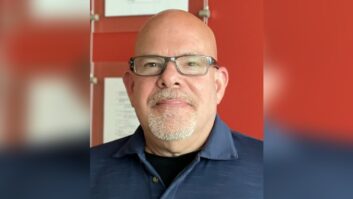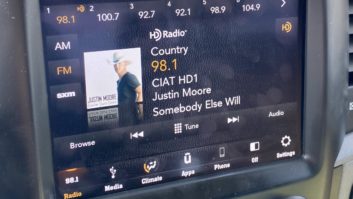Testing IBOC
Dec 1, 2001 12:00 PM, By Doug Irwin
Those who follow the trades and attend trade shows know by now that iBiquity has completed tests for its FM IBOC system, and tests for the AM version are currently underway. The tests and their procedures were specified by the NRSC. What interests most broadcasters is understanding the test objectives. At this critical point in the acceptance of IBOC, stations should be aware of the efforts being made to develop a workable and realistic system.
NRSC inquiry and objectives
In August 2000, the NRSC released a Request for Proposals offering all parties with functional IBOC DAB systems an opportunity to participate in the NRSC’s standards development process. IBiquity was the only organization that responded to this request. At one time, there were three IBOC proponents: USA Digital Radio (USADR), Lucent Digital Radio (LDR) and Digital Radio Express (DRE). Digital Radio Express was acquired by USA Digital Radio in 1999. IBiquity was then formed after the merger of USA Digital Radio and Lucent Digital Radio in August 2000. At the end of 2000, the NRSC had developed comprehensive FM IBOC laboratory test procedures in addition to field test procedures that focused on two areas. The first area of focus was the performance of the system under adverse (�real world�) conditions. The second was the effect that the IBOC transmissions had upon current analog FM transmissions (compatibility). IBiquity carried out the tests using the IBOC systems that had been developed by its predecessors, USADR and LDR.
Simply stated, the tests that the NRSC developed were designed to demonstrate conclusively that an IBOC system would provide a significant improvement over the current analog technology. Tests were developed that were both of an objective nature (laboratory) and of a subjective nature (field tests).
The laboratory tests were carried out by the Advanced Television Technology Center in Alexandria, VA. The NRSC and its observers were allowed access to all ATTC testing, and an NRSC representative took part in the lab’s work. The ATTC recorded the data from the tests. In addition to the objective measurements, ATTC recorded audio samples for subsequent subjective tests carried out by Dynastat in Austin, TX. Details of these tests will be discussed later.
The field tests
For the field tests, the NRSC specified many aspects, including the receivers that were to be used. These receivers were chosen on the basis of market information, as well as their performance abilities in their respective market segments. All four receivers were used for performance tests (in direct comparison to the digital receiver) and compatibility tests.
The NRSC defined the adverse conditions under which the IBOC system was to be tested in the field. These conditions were: a clean channel environment; physical impairments such as distance and terrain shielding; co-channel and adjacent channel interference; and multipath interference. The compatibility study looked at the effects of the IBOC transmission on co-channel, first adjacent, and second adjacent stations.
The NRSC also identified particular stations (and the driving routes) to be used in the field tests.
Members of the iBiquity staff made the field measurements. In most cases, an auditor from the ATTC was present. Additionally, an NRSC observer witnessed all of the tests.
Original equipment Auto Delphi PN 09394139 Aftermarket Auto Pioneer KEH-1900 Home Hi-fi Technics SA-EX140 Portable Sony CFD-S22 Figure 1. The various receivers used during the NRSC tests.
The measurements were both complex and thorough. From the whip antenna on the roof of the test vehicle, the RF was divided four ways. The first two outputs went to the two mobile receivers as shown in Figure 1. The third output went to the IBOC receiver itself. The fourth went to the spectrum analyzer on-board the truck.
Three sets of audio outputs from the respective receivers were recorded on a Tascam DA-98 digital recorder. This audio was used for subjective tests that were carried out later. An on-board computer was used to record data such as signal strengths (derived from the spectrum analyzer) and GPS information. In addition, the computer was used to store images from video cameras facing fore and aft of the vehicle. This visual information allowed the iBiquity testers to correlate reception anomalies heard in the recorded audio that were the result of environmental changes, such as overpasses and large trucks, that were encountered along the way during driving tests.
The field test stations incorporated in the NRSC test procedures were selected to assess system performance in common FM environments. Figure 2 shows the stations that were tested, and Figure 3 shows which environmental characteristic were scrutinized.
As each of these particular cases was evaluated, the data was recorded in the mobile test vehicle, and the audio recordings made were used for later subjective evaluations.
The stations and the results
The various stations were chosen because of certain unique characteristics that were useful in evaluating various test parameters.
Overall coverage
WETA has an extensive coverage area without any strong first- or second-adjacent interfering signals. The coverage of the digital signal was consistent out to the 35dBu level of the analog transmitter.
First-adjacent analog interference
Both WPOC and WNEW have first-adjacent channel interference, which does not have an effect on the digital coverage. Even in the presence of this interference, the digital coverage for each station went out to the 35dBu to 38dBu level of the analog transmitter.
Second-adjacent analog interference
Tests conducted on WNEW in the presence of strong second-adjacent channel interference from WBAB in Babylon, NY, attest to the robustness of the digital system. The digital coverage in this case extended to the 100dBu contour of WBAB. At that point the desired to undesired ratio (D/UD) was approximately -47dB. Similar results were obtained from the KLLC testing in the San Francisco market. KLLC has a strong second adjacency (KFFG) on 97.7 in the southern half of the Bay Area. The digital coverage of KLLC extended to within the 80dBu contour of KFFG.
Second-adjacent digital interference
WD2XAB was used to demonstrate the IBOC system’s ability to maintain digital coverage with a second-adjacent channel digital interference source. WD2XAB operated at 93.5 in hybrid mode (analog and digital signals broadcast simultaneously) while WPOC operated at 93.1, also in hybrid mode. While running 8W of digital power, WD2XAB still offered digital service up to the point where the desired to undesired ratio (with respect to WPOC) was -15dB.
Dual second adjacency interferers
WHFS has strong levels of second-adjacent interference from stations operating in the same market. WHFS transmits on 99.1, while WIHT transmits on 99.5 and WMZQ transmits on 98.7. The IBOC system broadcast on WHFS still gave partial digital coverage at the 120dBu contour of WMZQ.
WETA Washington, DC 90.9 B 75kW 185m 750W WHFS Annapolis, MD 99.1 B 50kW 142m 500W WPOC Baltimore, MD 93.1 B 16kW 269m 160W WNEW New York, NY 102.7 B 6kW 413m 60W WWIN Baltimore, MD 95.9 A 3kW 95m 30W KWNR Las Vegas, NV 95.5 C 92kW 351m 920W KLLC San Francisco, CA 97.3 B 82kW 315m 820W WD2XAB Columbia, MD 93.5 n/a 800W 15m 8W Figure 2. The stations used for the iBiquity and subsequent NRSC tests.
Coverage with multipath
Tests taken with KWNR in Las Vegas show that the system is robust, even while experiencing high levels of multipath. This was confirmed on tests done with WNEW, transmitting from the Empire State Building. Driving the streets of Manhattan, the user of an analog radio will encounter extreme multipath distortion. Yet, the IBOC system performed extremely well, rarely blending to analog from digital. Further tests on KLLC in San Francisco provided similar results.
Class A facility
Class A tests were performed on WWIN in Baltimore. WWIN has strong second-adjacent interfering stations (WHUR and WPGC from Washington) and a strong first-adjacent interfering signal (WSOX from Red Lion, PA). Yet, the digital coverage was basically the same as the protected contour of the station.
Terrain Obstructions
Even with terrain obstructions, the digital system is able to provide coverage that is comparable to the analog coverage. San Francisco and Las Vegas provided the greatest challenges related to terrain among the stations that were tested. In the case of the KLLC coverage of the Bay Area (with which I am very familiar), digital service was provided throughout the greater Bay Area, with the exception of the areas east of San Francisco that are severely shadowed by the East Bay hills.
Nearly all of the San Francisco stations have fairly large, on-channel boosters to provide coverage in these areas.
Subjective testing and results
It is widely accepted in both the telecommunications and audio industries that subjective testing is the gold standard for audio system evaluations. IBiquity believes that subjective evaluation using participants from the general population provides the best means to assess the true significance of the system’s performance. The NRSC believes that the use of the general population gives better insight into the potential acceptance of the system in the marketplace. About 480 people, from diverse demographic backgrounds, took part in the subjective testing. The subjective evaluation lab screened these participants for their ability to distinguish small impairments and/or differences in audio quality. Only participants who were trained and passed the screening test were used in the tests that generated data subsequently presented to the NRSC.
The audio samples that were used in the evaluations were derived from recordings made in the iBiquity mobile test vehicle, under the various conditions discussed above. The evaluators were given analog and digital samples that were recorded simultaneously from the same point of a particular test radial.
WETA Overall coverage in an area characterized by low interference WPOC, WNEW 1st adjacent channel interference WNEW, KLLC 2nd adjacent analog interference WD2XAB 2nd adjacent digital interference WHFS Dual second adjacent channel analog interference WNEW, KLLC, KWNR, WHFS Multipath WWIN Class A facility WNEW Centrally Located urban antenna KLLC, KWNR Terrain obstructions WWIN Low Level power combining Figure 3. Test stations were chosen because of certain characteristics that could be evaluated during the IBOC tests.
Using a test methodology known as Absolute Category Mean Opinion Score, the participants were asked to rate the quality of the audio samples as excellent, good, fair, poor, and bad. These answers were then translated in to numerical values (five through one), which were then used to draw conclusions.
The performance tests, taken in their entirety (counting the first- and second-adjacent channel interference, and the various other impairment tests such as noise and multipath), show conclusively the superiority of the audio of the digital system over the analog FM. Perhaps just as important as the baseline quality of the audio is the tremendous durability of the system, its proven ability to continue to operate in the presence of real world impairments. Finally, test results show that the introduction of IBOC will have no meaningful effect on existing analog stations and their listeners.
The success of iBiquity’s efforts to enhance the listening experience and to improve audio quality is borne out by the subjective evaluation results.
SCA testing
IBiquity carried out a series of measurements designed to test the compatibility of SCA transmission with that of IBOC. This was not part of the NRSC test, and was not as extensive as the NRSC tests, at least in the number of stations and real-world situations that were examined.
Most of the tests were objective, i.e., done in the laboratory. Using standard broadcast transmission equipment and commercially available SCA receivers, 67kHz and 92kHz SCA transmission were examined. The conclusion is that while a performance degradation can be measured, it is so small as to not effect the SCA system performance. A subjective measurement was done on WETA-FM using receivers and listeners located at the offices of National Public Radio. No one in attendance was able to hear any impairment of the 67kHz SCA in the presence of the IBOC carriers on WETA.
A typical digital SCA (centered at 66.5kHz) was tested in the lab and in the field (on WD2XAB). In the presence of the IBOC carriers, a slightly higher bit-error rate was measured, but the difference was negligible. Performance of an SCA system such as this will not be significantly altered by the presence of IBOC carriers.
On-channel boosters
Field measurements taken on KLLC in the San Francisco Bay Area (as part of the NRSC tests) show that IBOC will not obviate the need for analog booster transmitters that provide fill coverage in areas suffering from severe terrain impairments. Indeed, the iBiquity report states that the same areas that are now covered by analog boosters will be able to get digital coverage by small IBOC boosters.
While one always expects any organization’s report on itself to be painted in the most favorable terms, it is hard to do anything but draw the same conclusions iBiquity has after looking at the test results presented in its report to the NRSC. It is obvious from even the most meager knowledge of communications that our environment is permeated with digital radio transmissions. That technology is not new but is evolving in many favorable ways. The fact that the consumer wants digital audio is a given, as is the fact that analog FM has its drawbacks. The recent launch of XM Satellite Radio, with its great early success, and the imminent service launch of its competitor Sirius Satellite radio on February 14, 2002, compels the traditional broadcast world to embrace the IBOC technology, for its own good and long-term viability.
Doug Irwin is director of engineering for Clear Channel San Francisco.












